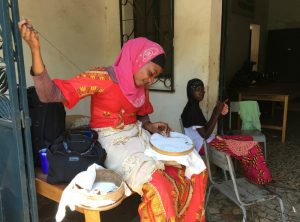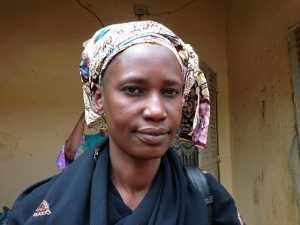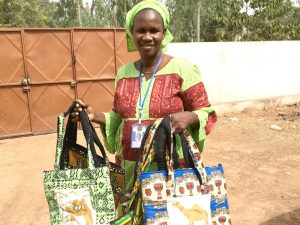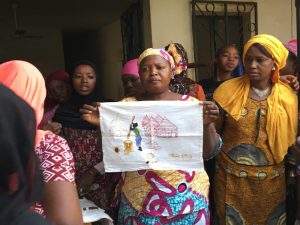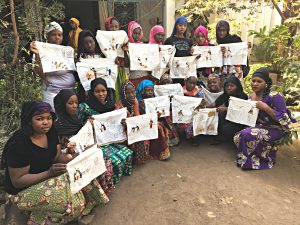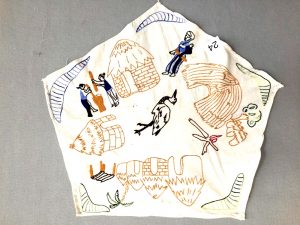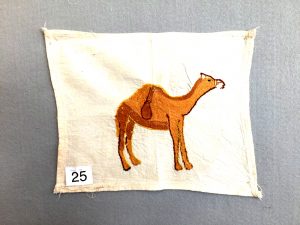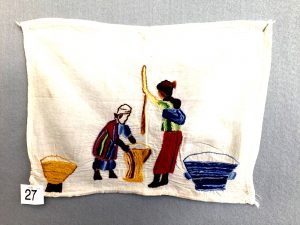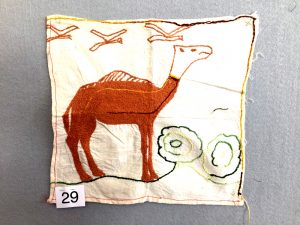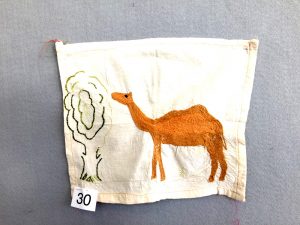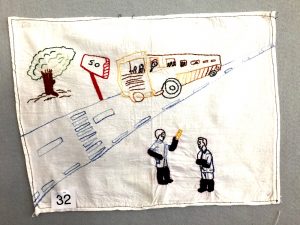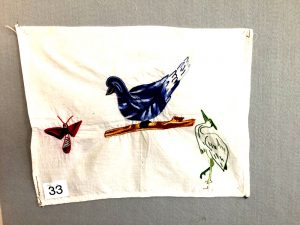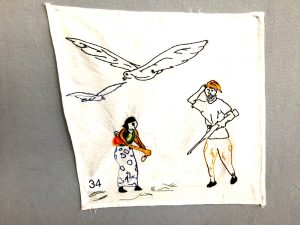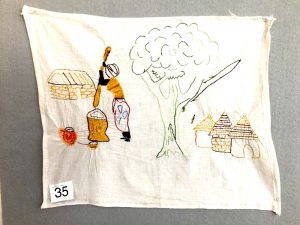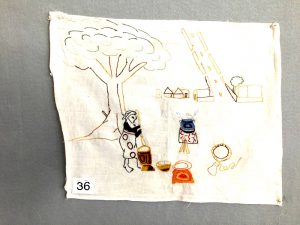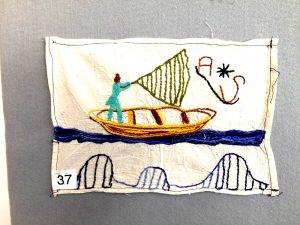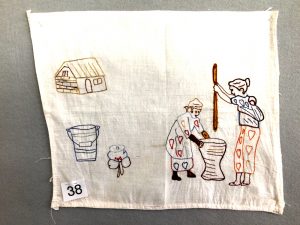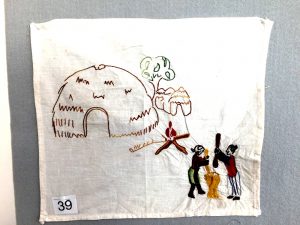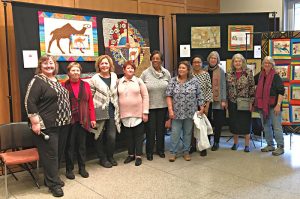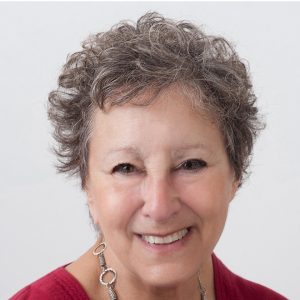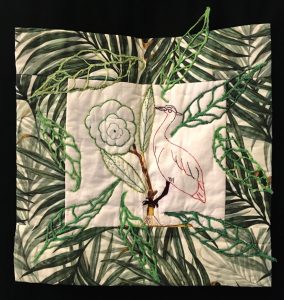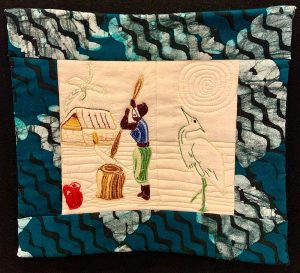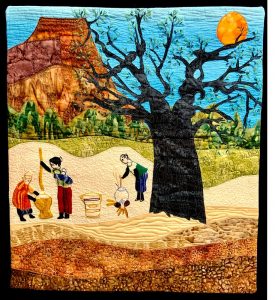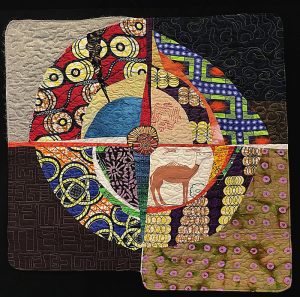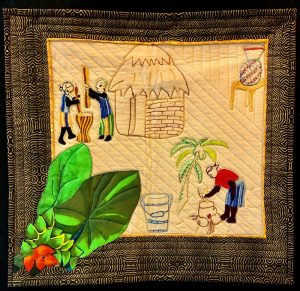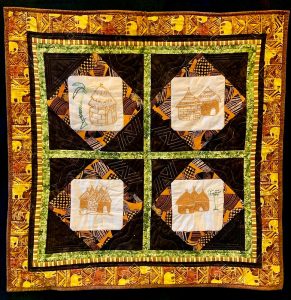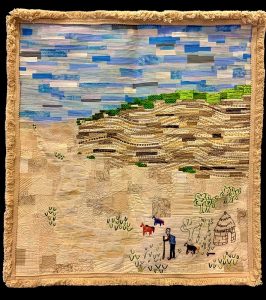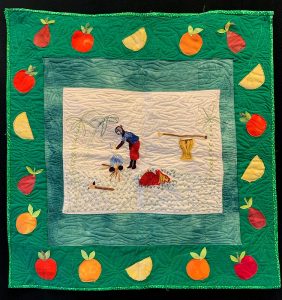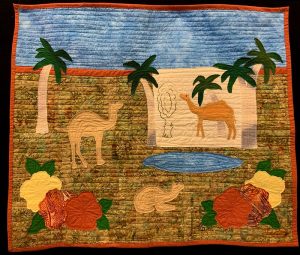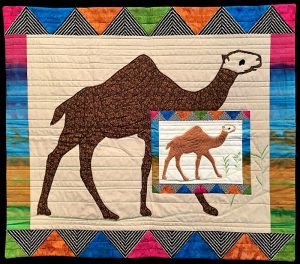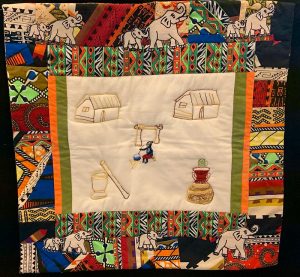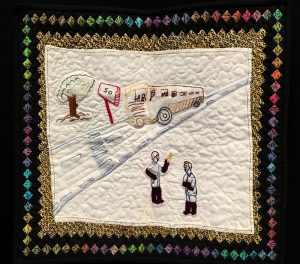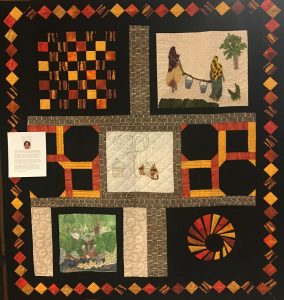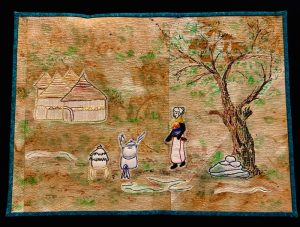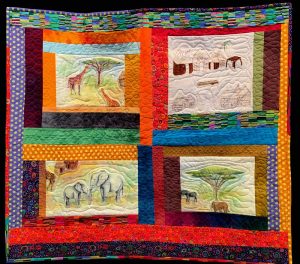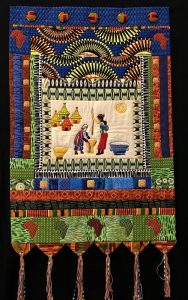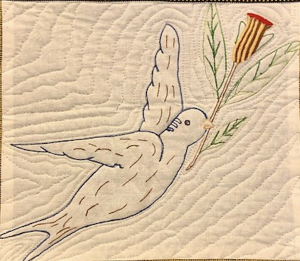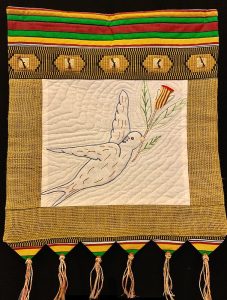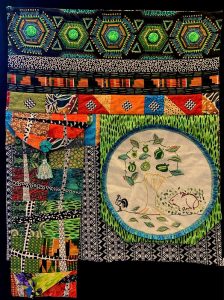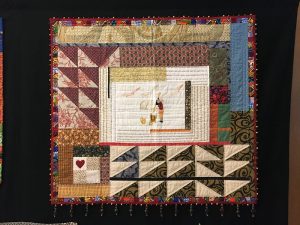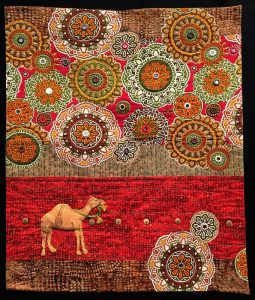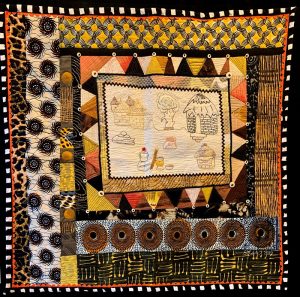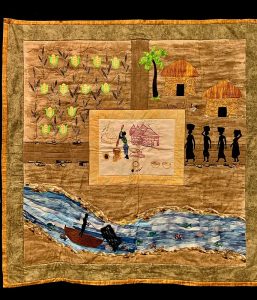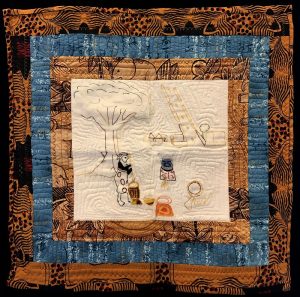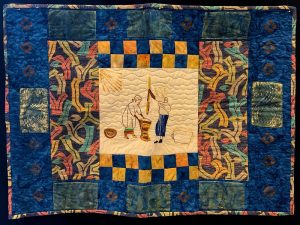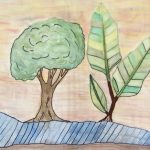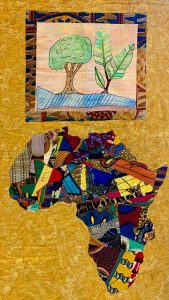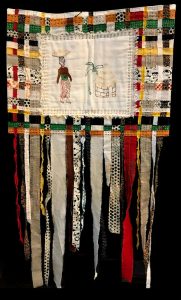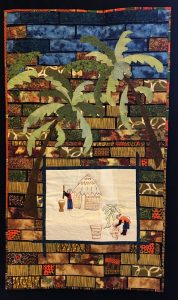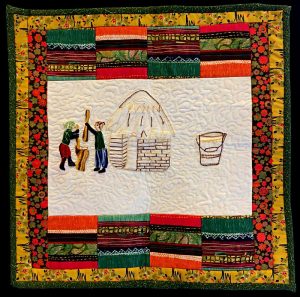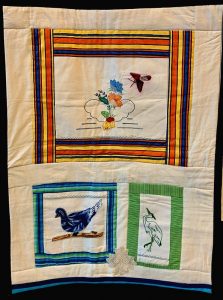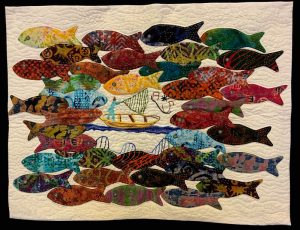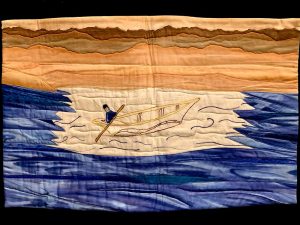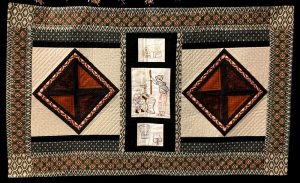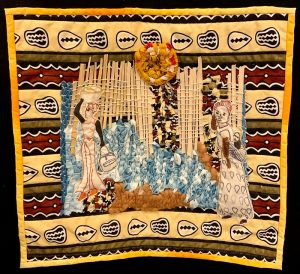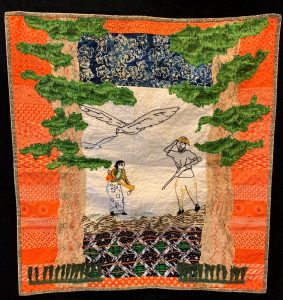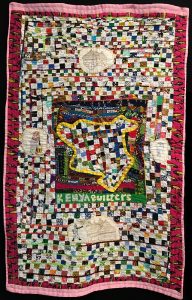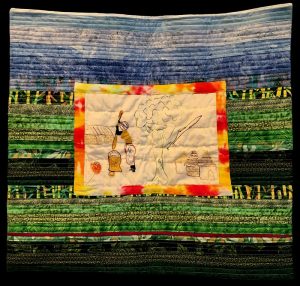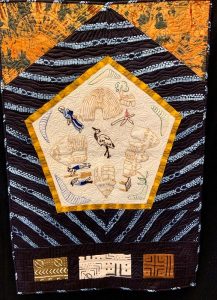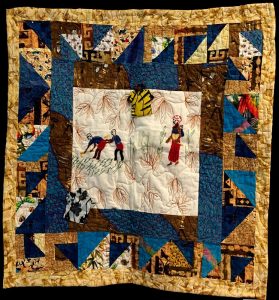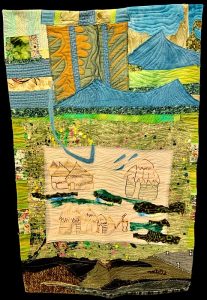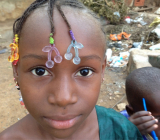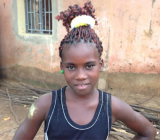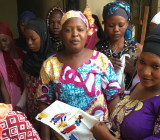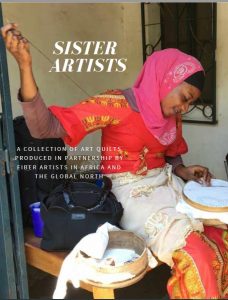Sister Artists Mali Quilts
Background
The Advocacy Project (AP) and Quilt for Change are working together to develop an exciting new partnership between survivors of gender-based violence (GBV) in Mali and quilters in the Global North.
Under the initiative, known as Sister Artists, survivors have produced embroidered blocks describing the life they led in northern Mali before they were assaulted and driven from their homes during the conflict. Their blocks are shown below on the second tab (Malian Sister Artists). Quilt for Change has invited quilters from the Global North to turn the blocks into an art quilt. Their finished quilts are featured on the third tab (Global North Sister Artists) together with a profile of the artist.
Quilt for Change is a long-time partner of AP and a leader in the use of quilting as a tool for social change. For AP, Sister Artists represents an important step in our efforts to support survivors from the conflict in northern Mali. Our engagement began in 2014, when we joined forces with Sini Sanuman (“Healthy Tomorrow’), a leading Malian advocate for women’s rights. Over the last five years, over 650 women have enrolled at a Sini Sanuman center where they were trained to make embroidery by Abi Konate and Massaran Traore, pictured below. Almost all of the artists lived in the north before fleeing the conflict and many live on less than $2 a day in Bamako. They hope to use their sewing skills to earn money.
This exciting initiative has attracted 41 talented quilters from the US, Canada, the UK and Kenya and we are enormously grateful to them for participating. Their quilts were shown for the first time at the Textile Museum in Washington on January 25, 2020 and auctioned on Bidding for Good. The auction raised over $8,000 which is being invested in GBV survivors in Mali. We are very grateful to Hollis Chatelain, a well-known textile artist, for her support and strongly recommend her website.
We have also produced a 90-page companion catalogue, Sister Artists, which is available from AP at $27.50, including postage. For more information email iain@advocacynet.org. We look forward to hearing from you!
Click here to read about the crisis of gender-based violence in Mali and Sini Sanuman’s response. Click here to learn about AP’s program of advocacy quilting.
Embroidered Blocks
Sister Artists from the North
Sister Artists from The Global North
The Sister Artists quilts shown on this page are being offered for auction on Bidding for Good between June 15 and June 28, 2020. All proceeds from sales will be invested in an embroidery and quilting project run by survivors of gender-based violence in Mali. Purchases of $500 or over will receive a free copy of the Sister Artists catalogue. To preview the auction and register as a bidder click here. Email iain@advocacynet.org or DCoffice@advocacynet.org for information.
Bird
Deborah Weir – California
Growing up in a “cold house with sharp angles and stone floors” gave Deborah an early appreciation for warm textiles, but it was as a student of costume design that she learned to love quilts.
Deborah is a mixed media artist who mostly uses textiles. Though contemporary in every sense, her work draws on traditional women’s work and uses gentle fabrics, thread and floss as well as edgier material like Tyvek and metals. Her style includes collage and embroidered surfaces as well as art quilts and weaving.
Deborah is committed to social justice and created pieces for Solar Sister and Water is Life. She was drawn to Sister Artists by the prospect of working with survivors of gender-based violence: “I often wondered about the artist and what she went through. Person to person projects are so powerful.”
In designing her quilt, Deborah chose a background of “jungly” fabric. She then placed her Malian bird in a wild habitat by bringing the border of leaves into the block and extending the border to give an impression of untamed vegetation. She used a machine to trace out the designs onto a water-soluble fabric and needle lace to stitch the designs. Deborah’s next quilt project will be on incarceration.
Deborah is a member of Studio Art Quilt Associates (SAQA) and Surface Design Association. She is the only non-Australian member of the Oz Quilt Network.
Check Out Deborah’s Website
Home, Work, Nature
Sue Bates – Rhode Island
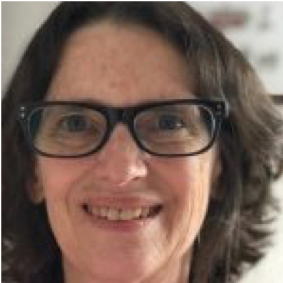
After working as an engineer for many years, Sue needed a creative outlet. She turned to fabric and painting and has never looked back. She particularly likes to dye and paint fabric.
Sister Artists immediately reminded Sue of an earlier project organized by a neighbor that had involved sending upholstery fabric to refugees in South Africa. The refugees turned the fabric into self-portraits which then returned to the US to be made into small quilts and auctioned: “It was fresh, imaginative and full of great color.”
Sue felt a strong connection with her Malian sister while working on her square. She knew that the woman has been uprooted from home and suffered violence, and this influenced Sue’s design: “I tried to imagine how she would like to be – serene, at home, surrounded by nature and taking care of her family.”
In making the border for her quilt, Sue used green fabric brought from Ghana by her nephew, who is in the Peace Corps. She cut her Malian square back to reduce the white space and used free motion quilting for the backing.
Sue is a member of Studio Art Quilt Associates (SAQA); and Quilters By The Sea in Portsmouth RI.
Cooking
Rhonda O’Keefe – New Hampshire
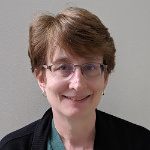 Rhonda leads a busy life as director of environmental safety at the prestigious Broad Institute in Cambridge. She also spends much of her spare time perfecting the art of handbell ringing at her local church. This does not leave much time for quilting. Adding to the challenge, local quilt guilds tend to meet during the day, when Rhonda is at work. In spite of it all, Rhonda is a quilt enthusiast.
Rhonda leads a busy life as director of environmental safety at the prestigious Broad Institute in Cambridge. She also spends much of her spare time perfecting the art of handbell ringing at her local church. This does not leave much time for quilting. Adding to the challenge, local quilt guilds tend to meet during the day, when Rhonda is at work. In spite of it all, Rhonda is a quilt enthusiast.
Rhonda is relatively new to art quilting and viewed Sister Artists as a way to experiment and learn. She was also drawn to the idea of advocacy quilting and was inspired by reading about the Malian artists on the AP site. Like many of the other quilters she has often thought about the young woman who made her block: “I count myself so lucky not to have been affected by violence and very privileged to hold something by someone who had been through that. I wanted to help.”
Rhonda spent several months on her quilt, working mainly at nights and over the weekends: “It sat on the wall while I thought about it!” She based her design on a giant Baobob tree that she saw during a safari in the Tarangire National Park in Tanzania last year. Rhonda used a sewing machine to attach the branches and did most of the thread painting and quilting on her long arm. She hopes to do more quilts, preferably on an African theme.
Hump Day
Colleen Ansbaugh – Wisconsin
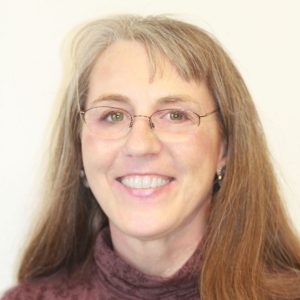 Colleen learned the basics of quilting from her mother, who was expert at crazy quilting. Colleen works in industrial textiles, where she currently tests upholstery for resistance to fire. She was first attracted to quilting for a cause by the Water for Life project and loves the idea of helping the Malian Sister Artists to learn a skill that will earn them money.
Colleen learned the basics of quilting from her mother, who was expert at crazy quilting. Colleen works in industrial textiles, where she currently tests upholstery for resistance to fire. She was first attracted to quilting for a cause by the Water for Life project and loves the idea of helping the Malian Sister Artists to learn a skill that will earn them money.
In designing her quilt, Colleen was determined to avoid a simple square rectangle and this accounts for the extended and curved square at the bottom right, as well as the uneven top quarter. She used the “Drunkard’s Path” quilting pattern for the circle and semicircle to further disrupt the sense of balance.
In making her quilts, Colleen dyes fiber and cloth by hand. She then adds more color with paint, silk screening, and felting. For Hump Day she used African cloth from a textile show in Chicago and left-overs from other quilt projects. She then brought out the brown and dun colors of the camel and sand with small pieces of red cloth and burlap. Colleen used antique dresser cloth on the front of her quilt and a long arm to complete the quilting.
Collen is a member of two guilds: A Patch of Lakeshore Quilters in Wisconsin; and Women Who Run with Scissors. She also serves as the Illinois and Wisconsin regional representative for Studio Art Quilt Associates (SAQA).
Check Out Deborah’s Website
Cooking at Home
Hope Barton – Connecticut
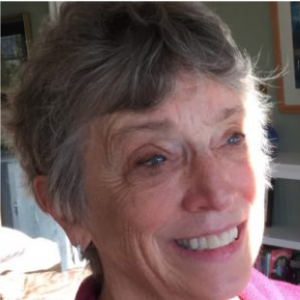 Hope started quilting as a practical way to keep her family warm. She then branched into art quilting and has made “hundreds” of quilts, many of them at the end of the day after finishing work as a nurse practitioner. Hope has received several commissions, including one recent quilt that commemorated a deceased acquaintance.
Hope started quilting as a practical way to keep her family warm. She then branched into art quilting and has made “hundreds” of quilts, many of them at the end of the day after finishing work as a nurse practitioner. Hope has received several commissions, including one recent quilt that commemorated a deceased acquaintance.
Hope believes strongly in giving and plays in a dulcimer group that raises money to provide heating for low-income families. She has visited Sierra Leone and Tanzania in Africa, but was mainly drawn to Sister Artists after handling cases of gender-based violence as a nurse: “Therapy often means just listening.” Making a quilt from the Malian block was, for Hope, a way to help the Malian sister to express herself: “I would love to have met her!”
Hope’s quilt design satisfies her passion for color, which she describes as “almost visceral.” Her main goal was to sharpen the colors in her Malian block: “To enhance not change.” With this in mind Hope used fabric markers to bring out the colors and added the red and green bouquet from fabric that picks up the green and red in the main block. Hope used machine quilting to complete her quilt.
Hope is a member of Studio Art Quilt Associates (SAQA); The Narraganset Bay Quilters; and The Northeastern Connecticut Art Group.
Malian Homes
Susan Charles – Louisiana
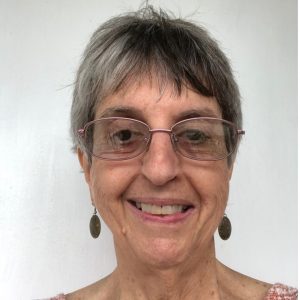 Susan has been quilting since the early 1990s when she entered a store and learned that they needed help: “I knew how to sew and said I can do that!” She likes art quilts because they can be “hung on walls and shown as art instead of put on beds.”
Susan has been quilting since the early 1990s when she entered a store and learned that they needed help: “I knew how to sew and said I can do that!” She likes art quilts because they can be “hung on walls and shown as art instead of put on beds.”
Susan was alerted to Sister Artists while taking a course from Hollis Chatelain, the renowned quilter who will adjudicate the quilt competition. In addition, Susan has a strong connection to Africa, having served in the Peace Corps in Kenya and Chad. She uses African fabric wherever possible.
Susan selected her Malian block because it features African houses, which she particularly likes. She cut her piece into four squares, each with a house, and built around them using African fabric. She thought a lot about her Malian sister artist while making the quilt, and thought the quality of her stitching was remarkably good for someone who had only recently learned to sew. Susan loves the idea of handing down sewing techniques from mothers to daughters and hopes her Malian sister is able to do exactly that.
Susan belonged to several quilt guilds in the past but now limits her involvement to Studio Art Quilt Associates (SAQA).
In the Fields
Diane Clapes – Georgia
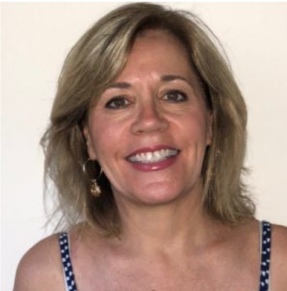 Diane has always loved working with fabric. She “dabbled” at quilting while raising a family but turned to quilting full-time when her last child went to college. Diane likes art quilting “because I don’t have to follow a pattern and can be more individualistic.” She still takes classes and has had several quilts hung in shows.
Diane has always loved working with fabric. She “dabbled” at quilting while raising a family but turned to quilting full-time when her last child went to college. Diane likes art quilting “because I don’t have to follow a pattern and can be more individualistic.” She still takes classes and has had several quilts hung in shows.
Diane was alerted to Sister Artists by three close quilting friends who she met after taking an online class together: “We challenge each other.” She has not been to Africa but felt a sense of solidarity with her Malian sister after spotting her in the group photo. “It helps to see the person who inspired you,” says Diane. “I thought of her experience while making my quilt and wanted to honor her.”
Before designing her quilt, Diana researched Mali and concluded that the land was mostly dry, brown and dusty. She was also influenced by Malian pottery and interesting rock formations. The large hill in her quilt is modeled on the Bandiagara escarpment in central Mali.
Diane wanted to integrate her design and the Malian block so completely that a viewer could not tell where one ends and the other begins. Hoping to place her Malian sister firmly in the fields, she used mono-printing to replicate the original designs (grasses and goats) and copied them into her quilt to expand the areas under cultivation. Diana used African fabric from her mother for the backing and added a trim that resembles grass.
Diane is a member of the Studio Art Quilt Associates (SAQA).
Food Needed for Life
Barbara Eisenstein – Maryland
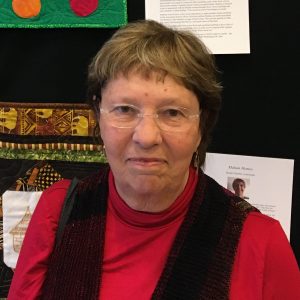 Barbara started with traditional quilting and moved to art quilting “because I wanted to use my imagination.” For the past five years she has worked from a studio in Rockville where she makes and sells dyed products.
Barbara started with traditional quilting and moved to art quilting “because I wanted to use my imagination.” For the past five years she has worked from a studio in Rockville where she makes and sells dyed products.
Barbara has extensive experience of using quilts to advance a cause. She contributed to two previous Quilt for Change challenges – Solar Sisters and Water for Life. Barbara was also part of a team from the PM Fiber Arts Guild that assembled the two Alafia Mali (“Peace in Mali”) quilts. The blocks for the two peace quilts were made by women in Mali, including some of the Sister Artists, and describe attacks of gender-based violence in painful detail. Barbara is pleased to get re-acquainted with the Malian women through Sister Artists and hope she can contribute to their healing: “You can do as much with images as words.”
Barbara viewed Sister Artists as an opportunity to make another strong statement – in this case about food in Africa. Over four million Malians are under-nourished and Barbara’s quilt displays a range of basic fruits. They are not specific to Mali but convey the message that fruit is a universal source of nutrition.
Barbara also added palm trees to her block and used hand quilting to give a feel of land being cultivated. She used light colors in order not to overpower the original design: “I wanted to make sure the Malian block stood out.”
Barbara is a member of Studio Art Quilt Associates (SAQA) and two guilds – the PM Fiber Arts Guild and NeedleChasers – in the Washington DC area.
Camels at the Oasis
Deborah Elouahabi – Virginia
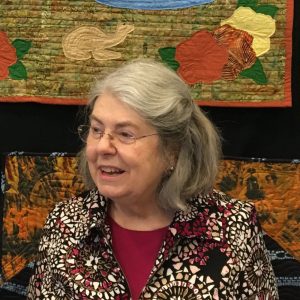 Deborah, 71, works for a government contractor and is a technical writer by trade, but her first love is art quilting. She learned how to quilt from her grandmother and went on to learn painting, embroidery and other fiber crafts. Art quilting allows her to bring it all together.
Deborah, 71, works for a government contractor and is a technical writer by trade, but her first love is art quilting. She learned how to quilt from her grandmother and went on to learn painting, embroidery and other fiber crafts. Art quilting allows her to bring it all together.
With Sister Artists, Deborah is also looking to quilt for a cause. She has not visited Sub-Saharan Africa but she has attended events on gender-based violence and forced marriage. She thought a lot about her Malian sister artist while working on her block and wonders what the future will bring for her.
Deborah enhanced her Malian block by adding new features that include deep green palm trees, camels, and a pool. One of the trees allowed her to cover up a wrinkle, but overall, she was impressed by the quality of the Malian stitching. Deborah used raw edge appliqué to add her pieces.
Deborah is a member of the DC Modern Quilt Guild; the Arlington chapter of Quilters Unlimited; and the Studio Art Quilt Associates (SAQA).
Study of a Camel
Ellen Fisher – New Hampshire
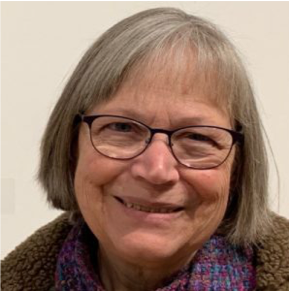 Ellen caught the quilting bug after seeing an exhibition featuring “watercolor quilts,” a technique using tiny squares of floral fabric. “I went home that night wanting to design my own watercolor quilt.” Ellen has been making art quilts ever since, presently at a rate of about 10 a year. She enjoys exhibiting her quilts, attending the openings, and exchanging ideas with the other artists. “That is the part of the process I like the best!”
Ellen caught the quilting bug after seeing an exhibition featuring “watercolor quilts,” a technique using tiny squares of floral fabric. “I went home that night wanting to design my own watercolor quilt.” Ellen has been making art quilts ever since, presently at a rate of about 10 a year. She enjoys exhibiting her quilts, attending the openings, and exchanging ideas with the other artists. “That is the part of the process I like the best!”
Ellen’s quilting has been influenced by her study of landscape architecture. She also has a degree in environmental biology.
Ellen’s design reflects her love of shapes and graphic art. Her goal was simple – to enlarge the image of the camel: “I saw a beautiful contoured drawing of a camel, and I wanted to make it bigger.” Ellen’s Malian sister had embroidered her camel in sections, using parallel stitches spaced closely together. The gaps between the sections became the contours of the camel’s body. Ellen loved the effect, and used a Xerox machine to produce a larger pattern of the camel. She then appliqued an enlarged fabric camel, machine stitching the contours.
The Malian artist had provided the hint of a setting and included a bit of land for the camel to walk on, and Ellen enhanced both slightly. But her main additions were the borders which pick up the colors of a desert landscape and hint at Malian mud cloth.
Ellen is a member of Studio Art Quilt Associates (SAQA).
Village Life
Ellena Georato – New Hampshire
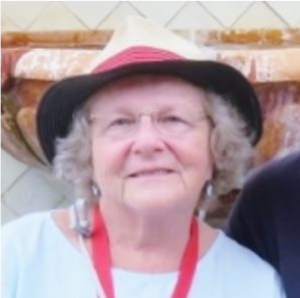 Ellena has been quilting for years but only recently turned her hand to art quilting, which she describes as being about “whatever you happen to feel on the inside as opposed to following a prescribed formula.” Ellena learned about Sister Artists from Janice Jones, another guild member.
Ellena has been quilting for years but only recently turned her hand to art quilting, which she describes as being about “whatever you happen to feel on the inside as opposed to following a prescribed formula.” Ellena learned about Sister Artists from Janice Jones, another guild member.
“I needed the practice in art quilting,” she says. “But I also really liked the idea of taking someone else’s embroidery and expanding it to tell a bigger story.” For her quilt, Ellena used old scarves and remnants of fabric in an African style and raw edge appliqué.
Ellena is a member of the Merrimack Valley Quilt Guild.
Bus Ride
Elizabeth Greene – Rhode Island
 Asked how long she has been quilting, Elizabeth replies that she made her first quilt for a nephew, now 46. She looks back on the years and feels that she has got better: “I know more tricks!” She reckons to have made over 150 quilts and given away about 25, mostly to charities. She prefers traditional quilting because the quilts are put to practical use by the charities and has made relatively few art quilts. But she likes art quilting because it “stretches her mind” and likes to fall asleep wrestling with a design: “My favorite quilt is the next one.”
Asked how long she has been quilting, Elizabeth replies that she made her first quilt for a nephew, now 46. She looks back on the years and feels that she has got better: “I know more tricks!” She reckons to have made over 150 quilts and given away about 25, mostly to charities. She prefers traditional quilting because the quilts are put to practical use by the charities and has made relatively few art quilts. But she likes art quilting because it “stretches her mind” and likes to fall asleep wrestling with a design: “My favorite quilt is the next one.”
Elizabeth entered Sister Artists to test her skills against others. After reading about what the Malian artists have been through she says: “I am just glad to be here.”
Elizabeth chosen the only block which tells a complete story (which appears to show two people getting off a bus near a speed limit). The artist also placed the bus at an angle to produce perspective. This meant that Elizabeth could not alter the block and had to focus on embellishment. Using a technique known as “Seminole Piecing,” which was originated by the Seminole Indians of Florida, Elizabeth sewed several strips of fabric together, cut the strips into smaller sections, and then rearranged them to form entirely different patterns: “Not many people use this technique, but it seemed to work for this image.” She used a machine in quilting.
Elizabeth is a member of Quilters By the Sea, in Portsmouth RI.
Safety in Numbers
Edith Gross – Louisiana
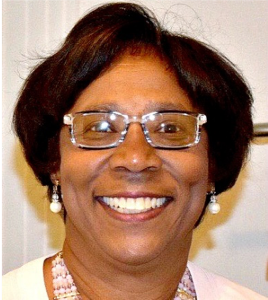 Edith’s love of fabric comes from her early years. She vividly remembers seeing her mother and grandmother reviewing a stitch that had gone wrong, and patiently going over it all over again. Edith made sure that the thread was re-rolled properly.
Edith’s love of fabric comes from her early years. She vividly remembers seeing her mother and grandmother reviewing a stitch that had gone wrong, and patiently going over it all over again. Edith made sure that the thread was re-rolled properly.
As someone who is keenly aware of the African American quilting tradition, Edith welcomed the chance to work on an African block. She entitled her quilt “Safety in Numbers” because women everywhere are at risk and have to be constantly aware of their surroundings: “Traveling in numbers provides camaraderie and safety.” This is particularly true in Mali, where travel can be very dangerous for women.
Edith’s quilt is an example of her style, which she describes as half-way between traditional quilting and art quilting. The story-telling runs from bottom left to top right. The original Malian block is at the center and represents the life and home of the Malian artist. The top right block, made by Edith, shows two women collecting water. At the bottom left is an image of African women making soap.
Edith used appliqué, dye-painting, and machine quilting. For the soap block she sketched the outlines of the image onto fabric and then painted it in using dye. Once dry she washed out the pencil lines. She used African fabric for the women carrying water and drew on her own stash of fabric for the rich red and orange blocks. Edith also used a basket stitch for straight lines. She hopes that her Malian sister artist will have the chance to see the finished quilt.
Under the Tree
Nancy Hershberger – Pennsylvania
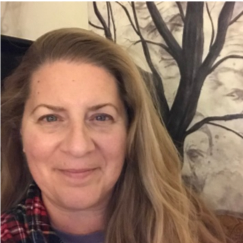 Nancy came to quilting in 2007 after suffering a family loss. She attended a class, bought a sewing machine and found it a lot of fun – as well as therapeutic. She was drawn to Sister Artists by the issue. She has never visited Africa but felt an empathy with her sister artist from Mali: “Despite being a victim of gender-based violence, she chose to depict everyday life and her home. It moved me to tears. I am humbled by her strength.”
Nancy came to quilting in 2007 after suffering a family loss. She attended a class, bought a sewing machine and found it a lot of fun – as well as therapeutic. She was drawn to Sister Artists by the issue. She has never visited Africa but felt an empathy with her sister artist from Mali: “Despite being a victim of gender-based violence, she chose to depict everyday life and her home. It moved me to tears. I am humbled by her strength.”
Nancy decided to re-arrange elements of her Malian block to create a more coherent design. She moved the two stoves to the center, made a large tree (“I’m into trees!”) and placed the stones at the foot of the tree. She researched Mali and found a country that seemed to be gray and brown with the occasional touch of green. This is reflected in the muted colors of her quilt.
For fabric Nancy used an old silk wedding gown which she cut up into strips. She then wrapped the silk around rusted machinery on the family farm in Pennsylvania, and left it in the rain for several days. The rust-dyed material provided the perfect color and mood for her quilt and seemed appropriate to the way the Malian women had been treated. Nancy then attached the pieces to the material using fusible glue and quilted the three layers together by machine.
Nancy is active in several guilds in Pennsylvania: the Pieceful Patchers Quilt Guild; the Log House Quilters Guild; the Salix Stickers Guild; Studio Art Quilt Associates (SAQA); and the American Quilter Society.
African Memories
Jackie Heupel – Texas
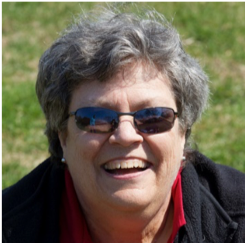 Jackie began quilting when she started to make a bedspread for her 9-year old son. Over forty years later the quilt is still unfinished but Jackie has become an artist with many talents. She paints on canvas, makes prints, and fashions crafts out of tin, wood or any other substance that catches her eye. She made and sold prints at a studio in the Torpedo Factory near Washington DC for several years.
Jackie began quilting when she started to make a bedspread for her 9-year old son. Over forty years later the quilt is still unfinished but Jackie has become an artist with many talents. She paints on canvas, makes prints, and fashions crafts out of tin, wood or any other substance that catches her eye. She made and sold prints at a studio in the Torpedo Factory near Washington DC for several years.
Jackie was anxious about entering Sister Artists at first when she saw what others had made, but decided to experiment with new techniques picked up from a recent class. She thought about her quilt for months and worked on it for about 30 hours.
Jackie’s quilt is a homage to wildlife in Africa. She does not know Mali, but has travelled in East Africa and plans to return to the Kenyan reserves this year. Her husband is a professional wildlife photographer.
Jackie created three new squares which each feature a prominent African species so as to send a continent-wide message about the importance of wildlife. She also added the image of a house, copied from her Malian block, to the three new squares to provide a common theme.
The three new squares were traced from photos taken by her husband and painted in using soluble ink. The next stage was to make the backing from strips of fabric. The four blocks were then added and stitched. Jackie says that her quilt has taught her new skills which she will now use again and again.
Jackie is a member of the Vereins Quilt Guild, Fredericksburg; the Hill Country Quilt Guild; and Studio Art Quilt Associates (SAQA).
Bounty of the Village
Janice Jones – Massachusetts
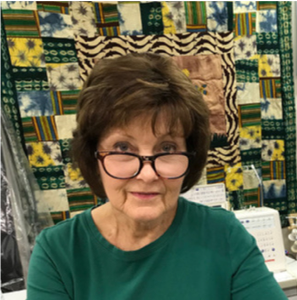 Janice was ten when she learned how to quilt from her grandmother, who worked at a New England textile mill and used to bring fabric home. Janice has produced a series of striking African quilts which can be seen on her website. She owes her love of African colors to her daughter, who worked as a nurse in Zambia and returned home with fabric.
Janice was ten when she learned how to quilt from her grandmother, who worked at a New England textile mill and used to bring fabric home. Janice has produced a series of striking African quilts which can be seen on her website. She owes her love of African colors to her daughter, who worked as a nurse in Zambia and returned home with fabric.
Janice’s favorite part of quilting is adding embellishments. For Bounty of the Village she chose fabrics which complement the colors and textures of the embroidered block from Mali. She then added appliquéd shapes, beads, prairie points and tassels. Images of a village and sun were added to provide balance and fill space.
Of Sister Artists Janice says: “This project has been so rewarding. Being a sister artist feels very special and I hope that we can somehow continue to be connected. It feels good to be reaching out and doing something positive.” She thinks the Malian artists did a “fabulous job” with their embroidery.
Freedom
When she learned that two of the Malian blocks were unclaimed, Janice generously offered to take them on in addition to her first choice: “It pulled at my heart strings to think that the blocks did not get chosen.”
Janice learned quilting at the age of ten from her grandmother, who worked in a textile mill and used to come home with scraps of fabric. Janice owes her love of African designs and fabric to her daughter, who brought fabric back while working as a nurse in Zambia: “I saw Africa through her eyes. The colors packed a punch!”
Finishing is the favorite part of quilting for Janice: “I love to use handmade beads, buttons, repurposed objects, fiber, stitching, stamps and various quilting techniques to add interest and texture.” Her passion is on display in Freedom.
Of Sister Artists Janice says: “This project has been so rewarding. Being a sister artist feels very special and I hope that we can somehow continue to be connected. It feels good to be reaching out and doing something positive.” She thinks the Malian artists did a “fabulous job” with their embroidery.
The Giving Tree
When she learned that two of the Malian blocks were still unclaimed, Janice generously offered to take them on, in addition to her chosen block. She could not bear the thought of them not contributing to the Sister Artist exhibition.
African designs and fabrics are something of a speciality for Janice. She learned quilting at the age of ten from her grandmother, who worked in a textile mill and used to come home with scraps of fabric. She owes her love of African designs and fabric to her daughter who brought fabric back while working as a nurse in Zambia: “I saw Africa through her eyes. The colors pack a punch!”
Finishing is the favorite part of quilting for Janice: “I love to use handmade beads, buttons, repurposed objects, fiber, stitching, stamps and various quilting techniques to add interest and texture.” Her passion is on display in The Giving Tree.
Of Sister Artists Janice says: “This project has been so rewarding. Being a sister artist feels very special and I hope that we can somehow continue to be connected. It feels good to be reaching out and doing something positive.” She thinks the Malian artists did a “fabulous job” with their embroidery.
Janice is a member of the Merrimack Valley Quilters Guild; the Hannah Dustin Guild; and Studio Art Quilt Associates (SAQA).
Check Out Janice’s Website
For My Sisters
Linda Kim – Texas
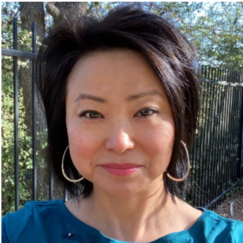 A stay-at-home mother with an MBA, Linda was looking for a creative outlet when she began to take classes at the local community center in ceramics, painting, sculpture, and art. Linda found that she loved working with wood, and this led to fiber material, which often resembled the texture in wood. Joining Studio Art Quilt Associates (SAQA) opened her eyes. “I’m a late bloomer!” she says.
A stay-at-home mother with an MBA, Linda was looking for a creative outlet when she began to take classes at the local community center in ceramics, painting, sculpture, and art. Linda found that she loved working with wood, and this led to fiber material, which often resembled the texture in wood. Joining Studio Art Quilt Associates (SAQA) opened her eyes. “I’m a late bloomer!” she says.
Linda is such a committed recycler that her quilt even includes bits of an old shower curtain: “My approach is wonderfully scrappy. I find all that I need on the free tables at meetings. I love knowing that it doesn’t end up in landfills.”
Linda spent the entire summer of 2019 on For My Sisters. She saw it as an opportunity to send a message about the environment, women’s rights and the family: “As an immigrant woman with two daughters I feel about the plight of women. There is injustice in every culture, based purely on gender.”
Apart from the central image from Mali, the most notable design feature of Linda’s quilt may be the small red heart on the left. This, she says, is a “message of love, hope and friendship from folks in the US to the women in Mali.” She surrounded the heart with a few squares of “patriotic prints” with blue and white stars. Linda also added sashiko thread and beads to her quilt. The old shower curtain was covered with big bold red circles, which seemed most suitable for the backing.
Linda is a member of the Austin Fiber Artists; the Austin Area Quilt Guild; and Studio Art Quilt Associates (SAQA).
Check Out Linda’s Website
May You Pass the Night in Peace
Cathey Labonte – Connecticut
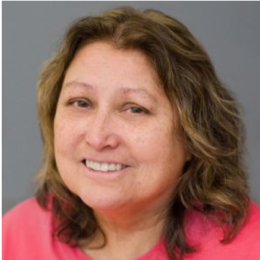 As a full-time civil engineer, Cathey has to make quilts in her spare time. She learned quilting from her grandmother and mother, and moved into art quilting after her grandchildren were born: “Art quilting allows for more imagination, decoration and techniques.” She particularly likes working the colors.
As a full-time civil engineer, Cathey has to make quilts in her spare time. She learned quilting from her grandmother and mother, and moved into art quilting after her grandchildren were born: “Art quilting allows for more imagination, decoration and techniques.” She particularly likes working the colors.
Cathey contributed a quilt for Water Is Life and was equally drawn to the theme of Sister Artists. Her Malian block carried the single image of a camel, which left Cathey with a virtually blank slate. She built a night sky around her camel, full of stars, in the hope of conveying tranquility and peace: “I thought about my Malian artist and what she had gone through. I wanted my design to give her a sense of calm.” The distinctive title of Cathey’s quilt is a translation of the Bambara (Malian dialect) words “Ala ka su here dama.”
Cathey describes her creative process as a lot of experimenting on her design wall: “I pin stuff on, stand back, take pictures, move things around, take more pictures and so on.” She made a number of sketches until she finally came up with the design. The actual stitching took about a week. Cathey also added a number of features including beads, metallic threads, batik from Indonesia, African fabric and even cork fabric (made from tree bark) to get her design absolutely perfect.
Cathey is a member of the Narragansett Bay Quilt Guild; the Quiet Corner Art Quilt Guild; and Studio Art Quilters Associates (SAQA).
Malian Medallion
Eleanor Levie – Pennsylvania
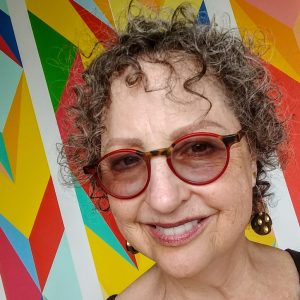 Eleanor loves advocacy quilting and was quick to answer the call to contribute to Sister Artists. She based her design on photos taken by a friend during a visit to the village of Siby in Mali, where geometric patterns are used during a house-painting festival. This inspired Eleanor to use the color and design of a log cabin:
Eleanor loves advocacy quilting and was quick to answer the call to contribute to Sister Artists. She based her design on photos taken by a friend during a visit to the village of Siby in Mali, where geometric patterns are used during a house-painting festival. This inspired Eleanor to use the color and design of a log cabin:
“I went with an asymmetrical medallion setting, sketched out on graph paper and used freehand-cut fused triangles and patterned fabric from my stash of African, batik, and hand-dyed and printed fabrics. There was quite a bit of seat-of-the-pants fudging as I added rounds of borders. Conveniently, African beads camouflage spots where angles and corners lack sharp points.”
Eleanor feels deep solidarity with the Malian artists: “If I could, I would pin a medal on each courageous woman anywhere who struggles and strives and supports her sisters. For now, my Mali Medallion will have to do. I honor the talent, courage and dignity of a young woman who embroidered a charming depiction of her home life in Mali.”
Check Out Eleanor’s Website
At the Heart of the Village
Glenda Mah – California
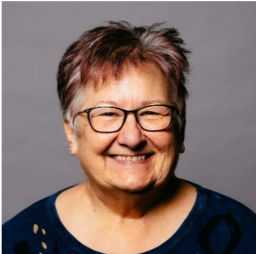 Glenda took up traditional quilting at an early age in an area of Kansas where people were thrifty: “They made their own blankets out of left-over clothes.” By the time Glenda returned to quilting, in 2006, she was looking for a challenge.
Glenda took up traditional quilting at an early age in an area of Kansas where people were thrifty: “They made their own blankets out of left-over clothes.” By the time Glenda returned to quilting, in 2006, she was looking for a challenge.
She found it when her husband was posted to Asia. Glenda was introduced to shibori, a Japanese method of dyeing that involves tying fabric and immersing it in indigo dye. Glenda developed a passion for natural dyeing and for indigo, which comes from a flower that is boiled and turns into a rich blue when oxidized. She brought her interest back to Oregon.
Glenda’s second discovery was mud cloth, which is one of Mali’s most famous exports. Glenda took a class in Seattle from a well-known Malian artist who incorporates traditional techniques from Mali and Japan and used mud from the River Niger in Mali in his classes. Glenda was delighted to learn that similar mud could be found near her home and now includes mud cloth in her own teaching.
Glenda was attracted to Sister Artists by the Malian connection and the message of social justice. She placed a series of village scenes around her block – a maize field, women returning from market, and fishermen at work in a river. She used her own mud cloth for the brown areas and raw edge applique and “fussy cutting” to produce a frayed edge. This seemed in keeping with the village theme.
Glenda is a member of Studio Art Quilt Associates (SAQA) and will soon join the Mid Valley Quilters Guild in Salem, Oregon.
Check Out Glenda’s Website
Meal Time
Veronica Mays – Rhode Island
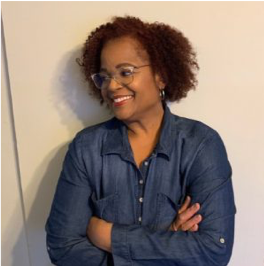 Veronica has been quilting in earnest for four years and gave up teaching last summer to quilt full-time. She runs her own company, Conaky’s Quilt Company, and produces vivacious quilts, usually in an African style.
Veronica has been quilting in earnest for four years and gave up teaching last summer to quilt full-time. She runs her own company, Conaky’s Quilt Company, and produces vivacious quilts, usually in an African style.
Veronica was attracted to Sister Artists by the cause: “Helping Malian women to succeed after being mistreated definitely appealed to me.” She entitled her block Meal Time partly because she loves cooking, and partly because she appreciated her Malian design: “I love the embroidery the artist chose for her piece and decided to add borders that bring out the colors within the panel while adding some African and Asian fabric flavors from my stash.”
Veronica is a member of two guilds in Rhode Island – Quilters by The Sea and Rhode Island Threads – as well as Studio Art Quilt Associates (SAQA).
Check Out Veronica’s Website
Grinding Maize
Karen McCann – Rhode Island
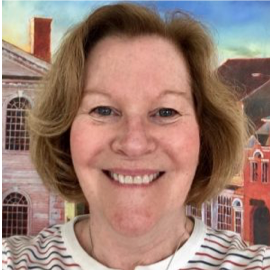 Karen knew exactly two people when she moved to Rhode Island and was looking for friends. She found them in an art group, which also offered her an outlet for her creative and professional interests. Karen has a background in graphic design and manages a family printing company with her husband. Not surprisingly she uses photographs in a lot of her quilts. This involves transferring the image onto muslin. Karen also uses thread painting to give an impression of movement and depth.
Karen knew exactly two people when she moved to Rhode Island and was looking for friends. She found them in an art group, which also offered her an outlet for her creative and professional interests. Karen has a background in graphic design and manages a family printing company with her husband. Not surprisingly she uses photographs in a lot of her quilts. This involves transferring the image onto muslin. Karen also uses thread painting to give an impression of movement and depth.
Karen was attracted to Sister Artists by the message and was moved when she found her artist in the group photo from Mali: “Seeing her from half way around the world made it seem much more personal and the world seem smaller. I’ve had her on my mind throughout and can’t imagine what she went through.”
Karen’s quilt seeks to enhance her original Malian block. She began by adding a sun, which she made by wrapping up cardboard and stamping it with the design. She then stitched her sun directly into the muslin.
Karen used a process known as Gelli plate print to make the surrounding blocks. She then cut two strips from fabric that mimicked aboriginal fabric (so-called because it comes from Australia and carries the shape of boomerangs) and attached these on either side of the central block. She then stamped on the deep blue border.
Karen is a member of the Rhode Island Threads group of fiber artists and Studio Art Quilt Associates (SAQA).
Check Out Karen’s Blog
Mali
Katherine Wilson – Maryland
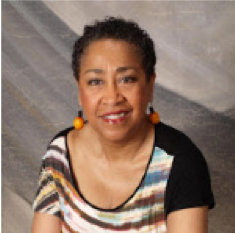 Katherine comes from a family where “sewing was as much a part of growing up as cooking.” Now retired, she enjoyed a distinguished career in philanthropy which included stints at the Ford Foundation, Legacy Foundation and the Appalachian Regional Commission. She is particularly proud of her efforts in advocacy and social justice. Katherine came to quilting after a loss in her family. She took a class with Bisa Butler, a well-known quilter who uses an African American style to capture slices of black life through history. Katherine was hooked and started taking classes and self-learning in quilting and various textile techniques.
Katherine comes from a family where “sewing was as much a part of growing up as cooking.” Now retired, she enjoyed a distinguished career in philanthropy which included stints at the Ford Foundation, Legacy Foundation and the Appalachian Regional Commission. She is particularly proud of her efforts in advocacy and social justice. Katherine came to quilting after a loss in her family. She took a class with Bisa Butler, a well-known quilter who uses an African American style to capture slices of black life through history. Katherine was hooked and started taking classes and self-learning in quilting and various textile techniques.
Katherine sees herself in the improvisational African American quilting tradition, using plenty of recycled scraps, African textiles and batiks. Her hunger for scraps has taken her to countless thrift shops where she has picked up discarded African fabric and even old African clothing.
Katherine has travelled to Ghana, South Africa and Egypt and like so many visitors marveled at the gorgeous colors: “You can never have a bad combination of African textiles. The bolder the better!” She felt a connection with the Malian Sister Artists but wanted to pay homage to the struggles of all African women with her quilt. The result is a vibrant, multi-colored continent made from various pieces of African fabric.
Katherine is a member of the African American Quilters of Baltimore; the Uhuru Quilters Guild; and Studio Art Quilt Associates (SAQA).
Carrying Maize
Judy Miller – California
 Judy was introduced to quilting when a shop opened in the area. She bought a sewing machine and started to take classes. For years she did traditional quilting. The Internet introduced Judy to a whole new world – modern quilting and art quilting. About 3 years ago, Judy took an online class in the elements and principles of art. There she met Ellen Fisher, Diane Clapes and Nancy Hershberger, three of the other Sister Artists. Ellen mentioned the project to the group and they all decided to participate.
Judy was introduced to quilting when a shop opened in the area. She bought a sewing machine and started to take classes. For years she did traditional quilting. The Internet introduced Judy to a whole new world – modern quilting and art quilting. About 3 years ago, Judy took an online class in the elements and principles of art. There she met Ellen Fisher, Diane Clapes and Nancy Hershberger, three of the other Sister Artists. Ellen mentioned the project to the group and they all decided to participate.
Judy had never entered a quilt challenge or show before: “I was scared to death! It forced me out of my comfort zone, but has done wonders for my confidence.” Judy was also attracted by the cause: “We need to express ourselves about what is happening in the world. Quilting opens that door.”
Judy began to research Mali and the issues. Seeing her sister artist in the group photo from Mali sealed the deal: “I felt a connection to her. My goal was to give her work greater impact.” Carrying Maize has a woven background, but contains a top, batting, and a backing, the traditional parts of a quilt. The strips in the weaving contain hand-painted fabrics, and burlap. Judy added embellishments using hand embroidery. Some threads and strips have been knotted and left to hang.
Judy is a member of Studio Art Quilt Associates (SAQA).
Preparing a Meal
Suzanne Munroe – Rhode Island
 Suzanne Munroe, a portrait artist, blogged on her website about the process of making her quilt for Sister Artists: “For as long as I can remember I have been creating some sort of art. I remember sewing on my great grandmother’s foot peddle machine in the attic at the farmhouse. I thought it was the coolest thing. All my cousins would be playing outside and I was up in the attic having a ball!
Suzanne Munroe, a portrait artist, blogged on her website about the process of making her quilt for Sister Artists: “For as long as I can remember I have been creating some sort of art. I remember sewing on my great grandmother’s foot peddle machine in the attic at the farmhouse. I thought it was the coolest thing. All my cousins would be playing outside and I was up in the attic having a ball!
“I love exploring all media and styles of art. I am particularly drawn to portraits. I am focusing on drawing, collaging or painting a portrait and then translating that design onto fabric. My hope is to pull the viewer into my pieces by capturing an emotion, causing a subsequent desire to feel, or wonder more about the piece.”
Suzanne used raw edge appliqué to make the two large trees and copied the design from the block itself. She was conscious throughout of the artists in Mali: “I can’t help but think of the women who fled from the conflict in northern Mali, survivors of gender-based violence (GBV) in Mali, and have used their blocks to remember the life they left behind.”
Suzanne was particularly drawn to the hut in her block: ‘I decided to mimic the strength of the hand-made walls to emphasize the strength of these women and what they have endured.” Huts also made Suzanne think of a community. She was inspired by one article (“Wisdom from an African Hut”) which described how families would gather in a hut, sit, eat and tell stories, “excluding no one.”
Suzanne is a member of Quilters by the Sea; Rhode Island Threads; and Studio Art Quilt Associates (SAQA).
Check Out Suzanne’s Website
In the Village
Wendy Overly – Massachusetts
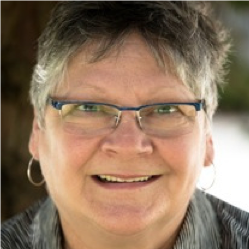 Wendy was the last Sister Artist to get back to us because she had just opened in a new play (“Admissions”) in Providence in which she plays the head of development at a prep school. As well as being a professional actor, Wendy bas been teaching theater since the mid-1980s. Asked what is the cardinal rule of acting she says: “Listening.”
Wendy was the last Sister Artist to get back to us because she had just opened in a new play (“Admissions”) in Providence in which she plays the head of development at a prep school. As well as being a professional actor, Wendy bas been teaching theater since the mid-1980s. Asked what is the cardinal rule of acting she says: “Listening.”
Wendy has long combined quilting with acting and reckons to have participated in almost as many quilt shows as plays. But Sister Artists is her first quilt challenge. Wendy’s first thought was that it would be fascinating to “support someone on the other side of the world that I will never meet.”
After checking out the project online, Wendy was also entranced by the fact that the artists on both countries share the same love of craft, regardless of lifestyles. She does not see the Malian artists as novices: “We were all trained by someone.”
In designing her quilt, Wendy imagined the family working in the garden in the middle of a field. She wanted to make the surrounding land as bountiful as possible, and chose fabric that looked like fields of crops. Her only addition to the block itself was to quilt in the open space.
Wendy does not belong to any guild and describes herself as a “rogue quilter!”
Check out Wendy’s Website
Flight
Kathleen Paduano – North Carolina
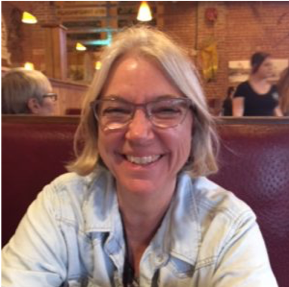 Quilting has long been part of Kathleen’s life. She was taught by her mother, and remembers making an apron for a doll at the age of five. She also recalls that the family was delighted to uncover a family quilt with a flower pattern made by her great-great-grandmother in 1854. Kathleen herself took up art quilting in 2011 when she moved to Colorado and loves the creativity it offers. She recently moved to Asheville in North Carolina, which is humming with folk art and creativity.
Quilting has long been part of Kathleen’s life. She was taught by her mother, and remembers making an apron for a doll at the age of five. She also recalls that the family was delighted to uncover a family quilt with a flower pattern made by her great-great-grandmother in 1854. Kathleen herself took up art quilting in 2011 when she moved to Colorado and loves the creativity it offers. She recently moved to Asheville in North Carolina, which is humming with folk art and creativity.
Kathleen contributed a quilt for the Solar Sisters challenge and is excited to again be connecting women through quilting with Sister Artists. She has travelled to South Africa and volunteered in Ecuador and Peru, all of which opened her eyes to other cultures and the lives of women outside the US: “There is such a sweetness to our humanity. Stitching offers a way to connect us all.”
Kathleen wanted her quilt to honor women in general. She decided to make three blocks out of the birds and the butterfly, and used bold colors and stripes to give it all an African feel. For the butterfly square, Kathleen used antique embroidery that her great aunt had given her years earlier, and was happy to see this precious piece used for such a good cause: “I wanted to honor women and how we create and make things that we share.”
Kathleen is a member of the Front Range Contemporary Quilters; and Studio Art Quilt Associates (SAQA).
Fish in Still Water
Dawn Piasta – Manitoba, Canada
 Until she recently retired, Dawn’s job was to bring physicians to rural communities in Manitoba. She began quilting at the age of nine and kept busy following patterns until her son urged her to make her own designs. She began by depicting her mother’s paintings in quilts. Dawn has made between 30 – 50 quilts and quilted items for family and friends. Many are used regularly as teaching references.
Until she recently retired, Dawn’s job was to bring physicians to rural communities in Manitoba. She began quilting at the age of nine and kept busy following patterns until her son urged her to make her own designs. She began by depicting her mother’s paintings in quilts. Dawn has made between 30 – 50 quilts and quilted items for family and friends. Many are used regularly as teaching references.
Dawn is committed to quilting for a cause. She was one of the first to volunteer when Quilt for Change launched a challenge on the theme of malaria, TB and AIDS. Dawn’s quilt featured a young girl carrying a malaria net and so impressed the Swiss manufacturer of the nets that Dawn and her husband were invited to Geneva for the exhibition. (Dawn was thrilled to see her quilt hanging at the United Nations and even more thrilled when a support fundraiser raised $650.) Dawn has been an enthusiastic contributor to Allison’s subsequent quilt challenges and Sister Artists was an obvious next step. She found photos of the Malian sisters online: “It made my soul sing to see how they were expressing themselves through stitching.”
The other main influence on Dawn’s quilt was her husband’s work as a fishing and hunting guide in Manitoba. She says that her fishy design came to her in a dream. She purchased African fabric and made the 39 fishes from individual pieces. Dawn used a turned edge appliqué on her fishes to ensure that the edges were smooth.
Dawn is president of the Crocus Quilt Guild and active in the Fibre Art Network of Canada; Textile & Fibre Artists of Manitoba; Studio Art Quilt Associates; and the Canadian Quilting Association.
Check Out Dawn’s Website:
Pirogue
Karen Pulaski – Massachusetts
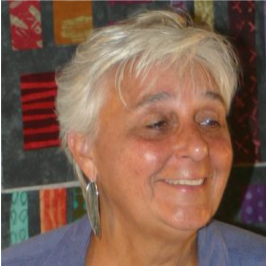 Karen came to quilting via her family bridal store. An accomplished seamstress, she would meet with quilters who worked at a nearby fabric outlet and urged her to share her secrets. This led to 25 years of quilt training, retreats, and quilt shows.
Karen came to quilting via her family bridal store. An accomplished seamstress, she would meet with quilters who worked at a nearby fabric outlet and urged her to share her secrets. This led to 25 years of quilt training, retreats, and quilt shows.
Karen is, however, a relative late-comer to art quilting. She was inspired by the Sister Artists challenge after meeting with Allison from Quilt for Change and Iain from AP. She particularly liked the idea of volunteering from home for such a good cause: “I teach a lot of children, so the idea of helping these Malian girls to learn a trade was fantastic! I feel really privileged to participate.”
In designing her quilt, Karen was determined not to break up her Malian block or fill out the white space. She was inspired by the fact that some of the sister artists in Mali had crossed two rivers to attend the embroidery training. Karen also loves water and takes every opportunity to work water into her quilts.
Karen chose blue batik fabric to match the blue in her Malian block and created the ripple effect of waves by using a rotary cutter to make long, thin slices. Karen then folded the edges over, and used a clear thin thread to stitch next to the fold. She then used a wooden iron to flatten it all out: “I hope the result is calming.”
Karen is a member of Studio Art Quilt Associates (SAQA); the Quilters Connection Guild; the Rising Star Quilt Guild; and a regular contributor to Material Mavens, an online blog.
Preparing Maize
Patricia Rennau, Vermont
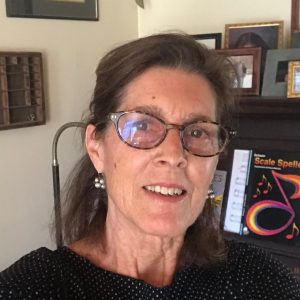 Patricia sees herself as a historian as well as a “wishful” practitioner of art quilting. She recently completed a graduate program in quilt studies while holding down a demanding job at the Washington West Supervisory Union. She has co-curated an exhibition at the New England Quilt Museum and wrote a Wikipedia entry on Molly Upton, one of the pioneers of art quilting.
Patricia sees herself as a historian as well as a “wishful” practitioner of art quilting. She recently completed a graduate program in quilt studies while holding down a demanding job at the Washington West Supervisory Union. She has co-curated an exhibition at the New England Quilt Museum and wrote a Wikipedia entry on Molly Upton, one of the pioneers of art quilting.
As a historian, Patricia is fascinated by imaginative forms of folkart quilts such as the narrative biblical quilts made by Harriet Powers and is humbled by the modern-day Migrant Quilt Project, which commemorates migrant lives lost while seeking to cross the southern border of the US. Her studies have convinced Patricia that quilting can be a tool for self-expression, advocacy and for improving lives: “Women have used quilts to express themselves, and their political views throughout the years.” This is what drew her to Sister Artists.
Patricia struggled with her design because her Malian block contained so much white space. She decided to separate the block into three vertical squares and used dark fabric that picked up the thread colors and – she hoped – resembled mud cloth.
Patricia is a member of the American Quilt Study Group, which organizes a yearly Seminar bringing together quilt scholars and enthusiasts to view quilts from new perspectives, and discuss aspects of women’s and material culture history; and the Mad River Valley Quilters Guild.
To Market
Pam Shanley – South Carolina
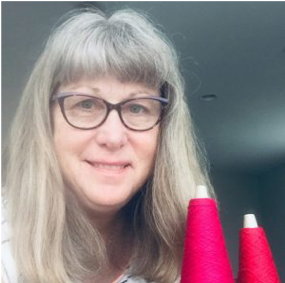 Pam brought plenty of local tradition to her Sister Artists quilt. She started sewing her own clothes while teaching at a High School and fell in love with folk art crafts in Appalachia, particularly weaving. During five years of living in Virginia, Pam contributed to many quilt shows. For one, which celebrated the 50th anniversary of the landing on the moon, she quilted moon craters in color. Pam shows her respect for tradition in South Carolina by giving demonstrations of weaving and sewing and serving as a guide at former plantations, dressed in 18th century clothing.
Pam brought plenty of local tradition to her Sister Artists quilt. She started sewing her own clothes while teaching at a High School and fell in love with folk art crafts in Appalachia, particularly weaving. During five years of living in Virginia, Pam contributed to many quilt shows. For one, which celebrated the 50th anniversary of the landing on the moon, she quilted moon craters in color. Pam shows her respect for tradition in South Carolina by giving demonstrations of weaving and sewing and serving as a guide at former plantations, dressed in 18th century clothing.
In preparing her Sister Artists quilt Pam researched Mali and saw water and grass amidst an arid desert. She separated the two women in her block to expand the image and allow for different weaving techniques. The sticks are made from muhli grass, which is commonly used to make baskets in South Carolina. The medallion was wrapped in a coil in the manner of another local product – Gullah baskets. For water, Pam used material dyed with indigo, which has been grown in Carolina since before independence. Pam has also made her own mud cloth.
With an art quilt currently on exhibition at the Library of Congress and To Market being shown at the Textile Museum, this is an exciting time for Pam. She is a member of the Palmetto Fiber Arts Guild; the Handweavers Guild of America; and Studio Art Quilt Associates (SAQA).
Check Out Pam’s Website
Hunting with Husband
Sandy Snowden – Berkshire UK
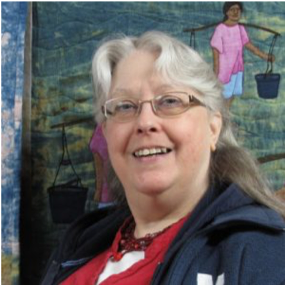 Sandy’s quilt is the only entry from Europe, although Sandy herself grew up in the US before moving to England. Her quilts have appeared at prestigious events including the annual Houston show, the Triennial exhibition in Europe with European Quilt Triennial, the Bernina fashion show, the Journal Quilt Challenge and the UK Festival of Quilts. Sandy tries to produce a quilt every month: “I have so many ideas in my head when starting a new quilt that I really have to concentrate hard.”
Sandy’s quilt is the only entry from Europe, although Sandy herself grew up in the US before moving to England. Her quilts have appeared at prestigious events including the annual Houston show, the Triennial exhibition in Europe with European Quilt Triennial, the Bernina fashion show, the Journal Quilt Challenge and the UK Festival of Quilts. Sandy tries to produce a quilt every month: “I have so many ideas in my head when starting a new quilt that I really have to concentrate hard.”
Sandy quilts for a purpose. She has made one quilt about the Chibok girls who were abducted in Nigeria and is now working on a second Several of her quilts feature refugees and religious persecution. Sandy was drawn to Sister Artists because it trains women to have a skill and seeks to increase their independence.
In interpreting her Malian block, Sandy felt that the husband and wife were trying to keep birds from eating their precious seeds. She added the trees along with tufts of grass at the bottom, and used mulberry bark for the trunks to reflect “ethnicity.”
In another nod to authenticity Sandy used shwe shswe fabric from South Africa and printed stamped fabric from Tanzania for the bottom piece. The brown ground is also Tanzanian fabric from Sandy’s scrap stash. Sandy is not as mobile as she once was, but takes pleasure from being able reach people through quilting: “I can sit at home and make people aware of stuff.”
Sandy is active in the Quilt Guild of the British Isles.
Check Out Sandy’s Blog
For Our African Sisters
The Salama Mamas – Nairobi, Kenya
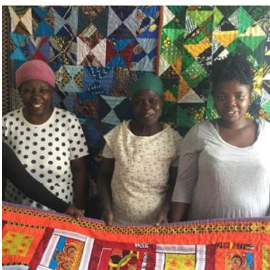 The sole African contribution to Sister Artists comes from artists who are – like their Malian sisters – under pressure. Robina, Lydia and Hanna, seen in the photo, are among five Kenyan Salama Mamas (“Rest and Peace”) who make and sell embroidered products in Nairobi.
The sole African contribution to Sister Artists comes from artists who are – like their Malian sisters – under pressure. Robina, Lydia and Hanna, seen in the photo, are among five Kenyan Salama Mamas (“Rest and Peace”) who make and sell embroidered products in Nairobi.
Salama Mamas was launched 5 years ago when Dorothy Stockell, an experienced American quilter living in Nairobi, offered quilting classes to the mothers of disadvantaged children from Gachie, a crime-ridden community in Nairobi. Dorothy was “flabbergasted” when the women developed their own unique style of quilting, now known as Salama Quilting, to produce a multicolored tapestry. With help from Dorothy, the Mamas developed their own business in Nairobi.
Lydia, Robina and Hanna offered their quilt to Sister Artists as a statement of solidarity with Malian sisters and African women generally. Coming from an underserved community themselves, they know all about gender-based violence. Their quilt shows Kenya at the heart of Africa to demonstrate the pride they feel in being Kenyan, and draws on their patented method. They cut up left-over fabric from one of their most popular products to make over a thousand tiny pieces and then laboriously attached the pieces, starting at the outside and working in. The backing is made from old Maasai blankets made from shuka cloth.
Dorothy divided the original Malian block into four pieces, which she attached to the Mamas’ quilt. Dorothy recently returned to the US after 37 years of living – and promoting quilting – abroad. She is still deeply committed to the Mamas.
Check Out Their Facebook Page
Same Earth, Same Sun
Betty Warner – Vermont
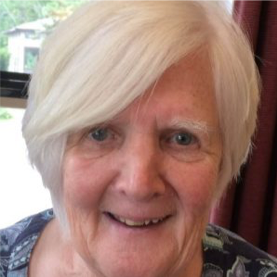 Betty has been art quilting since 2005. She credits her job in data communications with giving her the desire to solve problems and find new ways of expression, and loves the sheer variety of art quilting: “It’s messy, neat, abstract, realistic!”
Betty has been art quilting since 2005. She credits her job in data communications with giving her the desire to solve problems and find new ways of expression, and loves the sheer variety of art quilting: “It’s messy, neat, abstract, realistic!”
Sister Artists appealed to Betty’s sense of social justice. She is also fascinated by other cultures and hopes that her quilt has done justice to the Malian block, which provides a snapshot of the artist’s former life in northern Mali: “I imagined her trying to take care of her family, plant and grow food, and figure out ways to survive in her own environment.”
Betty is also keenly aware that her Malian sister was violently expelled from her home. She admires the artist’s courage in speaking out: “I appreciate this opportunity to participate. I see this as an act of faith by the Malian sisters to go out to the world like this.”
In making her quilt, Betty began by producing a series of long blocks, most of which are subtly different. She used red and yellow fabric that had been dyed by a neighbor for the striking central border around the Malian block. Betty feels the blue sky is particularly important for enhancing her quilt.
Betty was active in Women Against the Grain, a guild in Connecticut, before recently moving to Vermont.
Check Out Betty’s Website
Mali Village
Allison Wilbur – Rhode Island
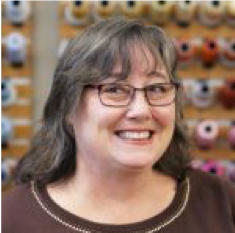 Together with her husband Dick, Allison is co-founder of Quilt for Change, which raises awareness on global issues that affect women and empowers quilt artists to become agents for social change. Decades of living overseas has brought global textiles, color combinations, and design elements into Allison’s quilts.
Together with her husband Dick, Allison is co-founder of Quilt for Change, which raises awareness on global issues that affect women and empowers quilt artists to become agents for social change. Decades of living overseas has brought global textiles, color combinations, and design elements into Allison’s quilts.
Allison and Dick curated several quilt exhibits in the Middle East. Returning to the U.S., Allison was inspired by an exhibition of quilts on the theme of Alzheimers, which affected her own family. She and Dick launched Quilt for Change in 2009 in Geneva, with the first exhibit sponsored by the US Mission to the UN and the Global Fund to Fight AIDS, Tuberculosis and Malaria. In 2011, Quilt for Change partnered with the UN Population Fund (UNFPA) on a quilt challenge on Women, Peace and Security. Subsequent challenges focused on issues of vital concern to women – energy and water. Solar Sister opened in 2013, and Water is Life in 2016. Quilt for Change has co-sponsored several exhibitions with The Advocacy Project (AP) and Allison has assembled advocacy quilts for AP, most recently on child marriage in Zimbabwe.
Allison was drawn to the remarkable pentagon shape and beautiful embroidery of her block. She brought out the color of the huts and birds with orange and blue fabric. Allison used indigo cloth from Mali for the wide border around the village, mud cloth from Mali along the bottom, and hand dyed damask in orange to enhance the elements in the center block. Allison looked for ways to highlight the arts and culture of Mali in her fabric selections and the quilting motifs which mimic the mud cloth designs.
Allison is a member of Quilters by the Sea; the Narragansett Bay Quilters Association; Rhode Island Threads and Studio Art Quilt Associates (SAQA).
Check Out Allison’s Websites Here and Here
In the Field
Sue Willows-Raznikov – California
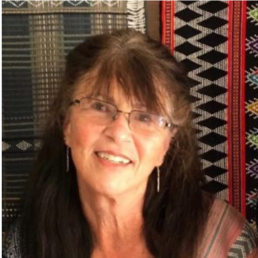 Sue brought her background as an educator, seamstress, and friend of Africa to her Sister Artists quilt. Her grandmother came from Russia and Poland where there was a strong tradition of mending blankets and old quilts. She made her first quilt in her 20s, when she made a living as a seamstress and remembers making men’s shirts with ruffled sleeves during the “hippie days.”
Sue brought her background as an educator, seamstress, and friend of Africa to her Sister Artists quilt. Her grandmother came from Russia and Poland where there was a strong tradition of mending blankets and old quilts. She made her first quilt in her 20s, when she made a living as a seamstress and remembers making men’s shirts with ruffled sleeves during the “hippie days.”
Sue studied anthropology and psychology at college and taught for nine years at community college before joining Stanford University. During her downtime she has worked as a substitute teacher in Panama, Kenya and Ghana, where she uses stitching to help students learn English: “On day 1 they would use needles to design something and learn such verbs as ‘pull’ and ‘push.’ On day 2 they would learn how chain stitch and thread the needle. On day 3 they would develop another design and so on, all the while learning the new language.” Sue tried to visit Mali twice, but without success.
The background has led Sue to see quilting as a communal activity that brings women together. When making her Sister Artists quilt, she thought of her Malian sister going off to the fields to work with other family members. In enhancing her block, Sue added African plants and two small shirts. Finding the right fabric is the “fun part” and she drew heavily on batik fabric picked up in Ghana and Kenya. Some of Sue’s fabric carries an insect design, which reminded her of cicadas in the evening. The leaf pattern brought back memories of the morning wind. The two little shirts are from waxy African batik.
Sue is a member of Studio Art Quilt Associates (SAQA).
Our Sister’s Hut
Julie Zaccone Stiller – California
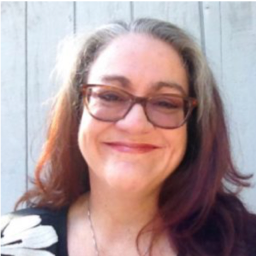 Julie took art training while at university in California. She is particularly interested in women’s issues and was immediately drawn to Sister Artists by the cause and the thought of making a connection with women in Africa: “Having the work of someone in my hands and making something it was such a treat!” Julie often thought about her Malian sister while making her quilt and wondered whether her life is improving: “Thank you very much for the opportunity to collaborate with a Sister Artist that I never would have encountered.”
Julie took art training while at university in California. She is particularly interested in women’s issues and was immediately drawn to Sister Artists by the cause and the thought of making a connection with women in Africa: “Having the work of someone in my hands and making something it was such a treat!” Julie often thought about her Malian sister while making her quilt and wondered whether her life is improving: “Thank you very much for the opportunity to collaborate with a Sister Artist that I never would have encountered.”
The biggest challenge Julie faced while working on her block was the white space and the fact that the huts – while beautifully made – were floating. She used the bright strips to place them on the same firm ground and laid torn-up fabric around the village to suggest a transition from a land that was disturbed and unsettled to the tranquil setting of the village. The top third of the quilt imagines where women are going and the rectangular shapes suggest buildings. The blue hook is intended to “draw your eyes up to the rest of the quilt.”
Julie used a variety of scrap material, including denim from old jeans and blue upholstery. She also used handmade paper stamped with African symbols which she tore to give the impression of rough edges. Julie reckons that her quilt took 60 hours to make. She has just entered a quilt in an exhibition celebrating 100 years of women’s suffrage.
Julie is a member of Studio Art Quilt Associates (SAQA); the Modern Quilt Group; and Contemporary Quilters and Fiber Artists in the Bay Area.
Sister Artists from Mali
Sister Artists from Mali
We are pleased to report that our Sister Artists quilt auction (June 2020) raised $10,210 from 314 bids. All 40 quilts were sold and the money will be invested in a project for the sister artists in Mali. Below, we invite you to meet some of the women who have worked with us in Mali since 2014 and made the auction possible.
Catalogue
The Sister Artists Catalogue
The Advocacy Project and Quilt for Change have produced a companion catalogue, Sister Artists, which is available from AP for $27.50, shipping included. The 90-page catalogue contains full-color photos of each quilt and a profile of each quilter. Email DCoffice@advocacynet.org or iain@advocacynet.org for more information and with shipping details. Please make payments through the Donate button on our home page.

